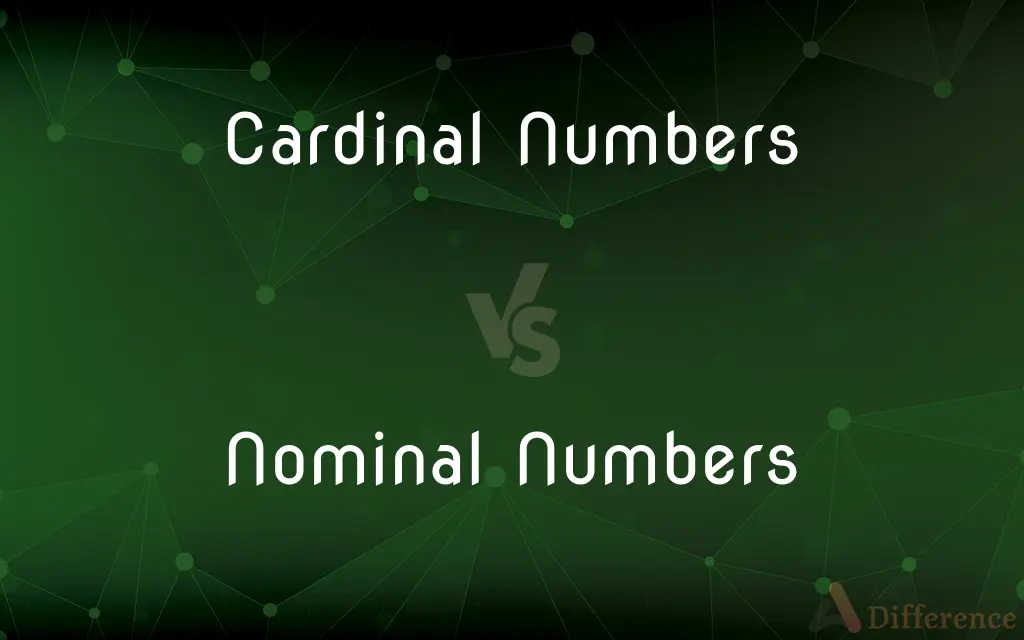Cardinal Numbers vs. Nominal Numbers — What's the Difference?
By Tayyaba Rehman & Urooj Arif — Published on February 9, 2024
Cardinal numbers denote quantity (e.g., one, two, three), while nominal numbers label or identify without implying quantity (e.g., room numbers, phone numbers).

Difference Between Cardinal Numbers and Nominal Numbers
Table of Contents
ADVERTISEMENT
Key Differences
Cardinal numbers represent quantities and can be added or subtracted to show how many of something there are. Nominal numbers, on the other hand, serve as identifiers or labels and hold no quantitative value. For example, "three apples" uses a cardinal number, while "Room 101" uses a nominal number where "101" simply identifies a location.
In mathematics and daily life, cardinal numbers are fundamental for counting and measurement. Nominal numbers, while not used for arithmetic, are crucial in organizing information, such as categorizing athletes by jersey numbers. Both types of numbers are essential, but their purposes differ significantly: one quantifies, and the other identifies.
Cardinal numbers can be ordinal when denoting position in a sequence, but nominal numbers remain purely symbolic and cannot be ordered in a meaningful way. For instance, "first" is an ordinal number derived from the cardinal number "one," whereas a nominal number like "Flight 502" cannot logically precede or follow another in a sequence based on its numerical value.
While cardinal numbers are used universally across cultures and languages with a clear consensus on their meaning, nominal numbers can vary widely in format and interpretation, influenced by local customs, such as differing formats for phone numbers or identification codes between countries.
Understanding the distinction between cardinal and nominal numbers is crucial in fields ranging from mathematics to data analysis, where the nature of the number determines its potential for computation and the type of information it conveys.
ADVERTISEMENT
Comparison Chart
Purpose
Indicate quantity
Serve as identifiers or labels
Quantitative Value
Yes, represent amounts
No, do not represent quantity
Use in Arithmetic
Used in mathematical operations
Not used for calculations
Example Contexts
Counting objects, measuring
Phone numbers, license plates
Relationship with Order
Can be ordered (first, second, third)
Do not imply order or rank
Compare with Definitions
Cardinal Numbers
Represents the size of a collection.
The class has twenty students.
Nominal Numbers
Does not indicate quantity or order.
Flight 507 is now boarding.
Cardinal Numbers
Used in counting to indicate how many.
I bought five apples.
Nominal Numbers
Can be any sequence of digits.
The code 007 is iconic.
Cardinal Numbers
Fundamental in mathematics for counting.
One plus one equals two.
Nominal Numbers
Often found in serial numbers.
The serial number is 11235813.
Cardinal Numbers
A number denoting quantity.
She has three dogs.
Nominal Numbers
Used for categorization or identification.
Her student ID is 4567.
Cardinal Numbers
Can be zero or any positive integer.
Zero tolerance policy.
Nominal Numbers
A number used as a label or identifier.
His jersey number is 23.
Common Curiosities
Can cardinal numbers be negative?
No, cardinal numbers are non-negative, including zero.
What is a nominal number?
A nominal number serves as a label or identifier without implying quantity.
Where are nominal numbers commonly found?
In identification, such as phone numbers, license plates, or room numbers.
How are cardinal numbers used in daily life?
For counting objects, people, or measuring quantities.
What is a cardinal number?
A cardinal number indicates the quantity of something.
Are Nominal Numbers finite or infinite?
Nominal Numbers are typically finite, representing distinct categories or labels within a specific context.
Can a number be both cardinal and nominal?
In different contexts, yes. For example, "4" can be cardinal (four items) or nominal (Room 4).
What is the purpose of using Nominal Numbers?
Nominal Numbers are used to categorize and classify data for organizational or descriptive purposes, such as in surveys or data analysis.
Are all numbers either cardinal or nominal?
Most numbers can be classified as either, but some, like fractions or decimals, serve other purposes.
Can nominal numbers be used in math operations?
No, nominal numbers are not used for calculations.
Is zero considered a cardinal number?
Yes, zero is a cardinal number representing no quantity.
Do nominal numbers have a numerical value?
They contain digits but don't represent a numerical value in terms of quantity.
Can you provide an example of using Nominal Numbers in research?
Certainly! In a survey, participants may be categorized by their gender as "male" or "female," representing Nominal Data.
Can ordinal numbers be derived from nominal numbers?
No, ordinal numbers are derived from cardinal numbers to indicate position.
Is "yes" or "no" considered Nominal Data?
Yes, "yes" and "no" are examples of Nominal Data, used to categorize responses as either positive or negative.
Share Your Discovery

Previous Comparison
GT2 RS vs. GT3 RS.
Next Comparison
Retesting vs. Regression TestingAuthor Spotlight
Written by
Tayyaba RehmanTayyaba Rehman is a distinguished writer, currently serving as a primary contributor to askdifference.com. As a researcher in semantics and etymology, Tayyaba's passion for the complexity of languages and their distinctions has found a perfect home on the platform. Tayyaba delves into the intricacies of language, distinguishing between commonly confused words and phrases, thereby providing clarity for readers worldwide.
Co-written by
Urooj ArifUrooj is a skilled content writer at Ask Difference, known for her exceptional ability to simplify complex topics into engaging and informative content. With a passion for research and a flair for clear, concise writing, she consistently delivers articles that resonate with our diverse audience.
















































